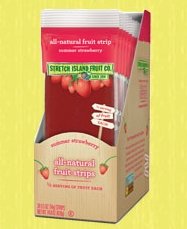 I try to keep fresh fruit on hand at all times, but I’m lucky–my kids love it and they eat right through it. Here today, gone tomorrow–that’s our fruit bowl. So, on the days when there isn’t anything fresh to pack in the lunches, I reach into the cupboard for eating fresh fruit at all. Marketing by companies, and the way that the copy is written on the label makes parents think that these “fruit my stash of freeze dried fruit. The package says it’s a whole apple (or some other serving of fruit), so it must be a good substitute, right? Well, not necessarily.
I try to keep fresh fruit on hand at all times, but I’m lucky–my kids love it and they eat right through it. Here today, gone tomorrow–that’s our fruit bowl. So, on the days when there isn’t anything fresh to pack in the lunches, I reach into the cupboard for eating fresh fruit at all. Marketing by companies, and the way that the copy is written on the label makes parents think that these “fruit my stash of freeze dried fruit. The package says it’s a whole apple (or some other serving of fruit), so it must be a good substitute, right? Well, not necessarily.
A recent article in the Health section of the LA Times stated that parents are turning to the substitutes–instead of the real thing–so often that kids aren’t nuggets”, “fruit leathers”, or in my case, freeze dried fruit, is just as good. Mark Kantor, professor of nutrition and food science at the University of Maryland in College Park who was quoted in the article states that, “Fruit snacks, whether or not they claim to provide a serving of fruit, don’t offer all the nutritional benefits of whole fruit and often contain added sugars and sometimes fats.”
The article goes on to explain that, “The snacks usually derive their fruit content from the same few sources: purée of apple or pear, apple juice concentrate and grape juice concentrate. Apples, pears and grapes are such popular ingredients in fruit snacks because they’re naturally very sweet, says Anuradha Prakash, professor of food science at Chapman University in Orange. (Prakash is also a spokeswoman for the Institute of Food Technologists, as is Kantor.)
Sugars, in addition to vitamin C, potassium, fiber and an array of antioxidants, are the key nutrients in such fruits, she adds — whole fruits, that is. But the words “juice” and “purée” on package labels are an indicator that most of the nutrients didn’t make it into the final, processed product. Vitamin C levels drop during processing because the vitamin is sensitive to heat. Fiber is removed when a fruit is pressed into a juice, and so are antioxidants, many of which are found in the peel.”
What does stay in the packaged fruit is sugar–it goes from the whole fresh fruit all the way into the final product in the packaging. And, many snacks that state “made with real fruit juice” mostly have “added sugars in the form of corn syrup or high fructose corn syrup, and some contain vegetable oils, i.e., fats.”
Bottom line–keep the fruit bowl filled–the less packaged fruit the better.